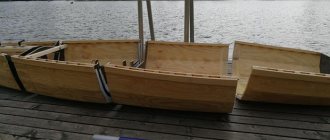When the fishing and boating season comes to an end, every shipowner is faced with the question of how to properly organize the winter storage of a PVC boat. This task is not so simple, because... hides many nuances. For example, what is the best way to store a PVC boat in winter: inflated or deflated? Or at what temperatures is it correct to store a PVC boat and is it possible to leave the boat in an unheated garage? All these, as well as other important aspects of winter storage of boats, will be discussed in detail in today’s material.
General information on how to store a PVC boat in winter
When purchasing an inflatable PVC boat, we carefully study the characteristics of the vessel, in particular the service life of the product declared by the manufacturer. As a rule, PVC materials are quite durable and, with proper care, last at least 10 years. But the key word is “proper care.” And it lies not only in the proper operation of the boat on the water, but also in properly ensuring its storage in the off-season. So how to preserve a PVC boat in winter? Let's figure it out.
Suitable temperatures
Let's start with the features of PVC fabric and temperature conditions. Sometimes some manufacturers claim that their boats can be freely operated in the temperature range from -30 to +30°C. But in reality it turns out that already at -10°C PVC begins to noticeably harden, which ultimately leads to the appearance of microcracks and deterioration of the vessel’s condition. And if we talk about a folded boat, then all the fold lines at the slightest touch and attempt to unfold are at risk of deep cracks appearing. Therefore, it is highly not recommended to store a PVC boat in the cold.
Now, regarding high temperatures. There are quite a few cases where an inflated boat was left in the sun, which led to the rupture of the cylinders due to increased pressure and overheating. So, you should also be careful with temperatures above +25°C. Even when deflated and folded, a PVC boat stored next to a battery or stove can receive irreparable damage. The material will begin to deform, lose wear resistance and emit toxic fumes, which can be harmful to the health of people in the same room. Thus, it is better to ensure that PVC boats are stored in winter at a temperature range from 0 to +25°C.
Here we note that the room should not have high humidity or, conversely, excessive dry air.
Boat manipulation
When it comes to the question of how to store a PVC boat in winter, the method of preserving the vessel is also extremely important. Essentially, there are 2 main methods:
- Keeping the vessel inflated.
- Packing the boat in a cover bag.
It is believed that it is better to store a PVC boat in winter the same way it is used during the active season, i.e. pumped up. At the same time, it is recommended to lower the cylinders slightly to avoid a surge in air pressure. But this storage method is only relevant if there is a spacious room with a suitable temperature and humidity level. Most fishermen do not have such extra “square meters”, so they can only use the second method - folded storage.
To pack the boat into the case, you need to deflate the air and carefully fold the boat. There is no need to press hard on the folds, otherwise at sub-zero temperatures the folds will “tan” and cracks will appear. Also, do not sprinkle the material with talcum powder - such a procedure is only required to store the rubber boat. For PVC materials, you can use special solutions or do without treatment with protective agents altogether.
Room type
For many boat owners, two questions are relevant at once: how and where to store a PVC boat in winter. We have already answered the first part, now we will give some recommendations on the second point.
Let's start with whether it is possible to store a PVC boat in the garage in winter. It’s difficult to answer unambiguously here, because... garages are different. If the space of the room allows you to hang an inflated boat from the ceiling, and at the same time it will not be subject to high humidity and temperature changes, then storing the boat in the garage will be quite justified. In cases where the garage is not heated, or even worse, leaks and is blown out, the verdict is different: storing a PVC vessel is highly not recommended. Because in such conditions it is simply impossible to ensure proper preservation of the vessel’s operational qualities.
Next, let's talk about premises such as sheds and outbuildings. The main criteria here are the same: sufficient warmth and dryness of the room, but one more requirement is added - the absence of rodents. Of course, pest animals are unlikely to get to an inflated boat attached to the ceiling, but they will certainly gnaw through a bag with a folded boat. Therefore, in order not to find a sieve instead of a PVC boat in the spring, first check the room for the presence of rodents and take appropriate measures to prevent their appearance.
You may be interested: Replacement of a certificate for the right to operate a small boat - procedure
And finally, storing a PVC inflatable boat at home in winter. This option is also quite common, and usually involves packing the boat in a cover bag (unless, of course, you are ready to allocate a separate room for the watercraft). There are several nuances worth noting here.
- Avoid proximity to heating devices. It has already been noted that PVC material is sensitive to high temperatures.
- Do not place heavy, much less sharp, objects on the packed boat. The weight of the cargo can deform the hull of the vessel and lead to cracks in the bends, and proximity to sharp skewers, knives and similar objects ultimately results in punctures in the cover and the boat stored in it.
- It is advisable to store the package with a PVC boat outside of residential premises, i.e. not in the rooms, but in the closet, corridor, mezzanine, balcony, etc. This is dictated by safety precautions, because... unventilated PVC material may emit harmful fumes.
- When storing a folded boat on the balcony during severe frosts, do not move the package or touch it. If the frost has “grabbed” the PVC, then at the slightest touch there is a risk of cracks forming, so it is better to leave everything as is and wait for the temperature to rise, then the boat will smoothly “move away” on its own.
This is how, in general terms, you can ensure proper storage of a PVC boat in winter, i.e. avoid unwanted damage to the hull and deterioration of the watercraft’s parameters. Now let’s move from the general to the specific, and consider a detailed guide to preserving a PVC boat during “downtime” in the off-season.
Stages of preparing a boat for winter storage
So, we noted how to properly organize the storage of a PVC boat in winter, but have not yet revealed another important point: preparation for preservation. We will correct this shortcoming and tell you how to prepare a PVC boat for winter storage, taking into account all the small nuances. In general, conservation can be divided into the following stages.
Preparing and cleaning a PVC boat
The first point in the guide on how to properly store a PVC boat in winter is washing and drying the craft. At the same time, they wash the PVC boat for the winter thoroughly and using special equipment. The process is divided into several steps.
- The vessel is inflated, after which surface cleaning is carried out to remove dust and dirt. At this stage, you should take a soft brush and a dry cloth for work. Particular attention should be paid to the joints of the sides and the bottom, where small particles of debris fall.
- Prepare a soap solution. Usually, available products are used for this (laundry or regular soap, washing powder, etc.), but if desired, you can use special products for washing boats made of PVC materials.
- Treat the PVC boat with the prepared solution, applying it to the surface with a soft cloth (it is better to take a flannel napkin). At the same time, the watercraft is also checked for the presence of invisible punctures: if bubbles begin to appear on the surface after applying soap, then there is an air leak in that place.
If such damage to the hull is detected, the problem should be repaired using a repair kit before sending the boat for winter storage. Otherwise, the size of the puncture may increase and repair will be more complicated. By the way, any damage, be it dents on the aluminum hull of a boat, cracked plastic on a boat, or a puncture on a rubber boat, is always repaired before storing it for the winter!
- Wash off the soap and leave the boat to dry for at least a day. It is very important that not a drop of water remains on the body, because... At the first frost, the moisture will quickly freeze and lead to cracks in the housing. And again carefully check the joints of the sides with the bottom, because Often the water that gets in does not dry out completely. To be 100% sure, don’t be too lazy to “walk” through the cracks with a hairdryer on the cold air setting.
In the meantime, while the craft is drying before final winter storage, it is worth paying attention to the rest of the gear. After all, it is important not only to properly store a PVC boat, but also to keep the oars, seats, floorboards, etc. in proper condition.
With oars, everything is simple: wash off the dirt and leave the instrument to dry. But before washing, plywood parts should be checked for damage to the paintwork. The fact is that if moisture gets into an unprotected area, it will penetrate inside the structure and delaminate the material, rendering the product unusable. A thorough inspection will help identify a violation of the protective layer.
If a malfunction is detected, the product should be dried and the protection restored by treating the area with drying oil and paint. Next, the plywood is dried again for at least a day, after which it is packaged and sent for storage in a dry room in which sudden temperature changes are not expected. Comfortable humidity and temperature conditions are important to avoid the risk of mold that corrodes the wood.
Packaging and storage
If you plan to store a PVC inflatable boat in the winter in the garage under the ceiling, then all that remains is to secure the dried watercraft on slings or a car trailer. For those who are going to completely mothball the vessel, preparing the PVC boat for winter, and the rest of the boat arsenal, continues.
The dried boat is transferred to a flat surface and the air is completely pumped out, while the valves are left open. Then, carefully, without unnecessary pressure or clamping, they begin to fold the deflated body, if necessary, leveling the fabric to remove residual air from the cylinders.
It is advisable to fold the boat according to the “factory” layout, which is indicated in the boat’s passport. If the instructions are lost, we recommend using the universal method: first, the sides are laid lengthwise until they touch the edges of the transom, and then, starting from the transom, the boat is rolled up and placed in a cover. Once again, please note that you should not press on the folds or bend the roll in any way.
This completes the preservation of the boat for the winter; all that remains is to select a room in which the humidity level and temperature are suitable for storing PVC boats. But we have already talked about these features in detail above.
Preservation of outboard motor
And a separate point in the guide on how to store a boat in winter is worth noting the preservation of the motor. This procedure is also carried out in stages.
- Extracting fuel from the carburetor (done during the last trip to the water). To do this, before turning off the engine, turn off the fuel valve and finish off the remaining gasoline in the system. Otherwise, the fuel remaining in the chamber over the winter may stratify and clog the channels.
- Removing the motor and installing it on a convenient workplace (special rack, trolley, etc.).
- Cleaning the propeller and engine legs from layers of dirt, sea salts, algae, etc.
- Flushing the cooling system.
- Preservation of the cylinder-piston group. It consists of unscrewing the spark plugs and pouring oil into each cylinder.
- Treatment of engine parts and mechanisms with a special preservative lubricant.
After the work is completed, it is necessary to dry the washed parts and completely reassemble the engine. The motor prepared for preservation can be simply placed in a bag and conveniently placed in a warm, dry room. Recommended temperatures for storing motors are from +6 to +20, and sudden changes and drops to “minus” are not at all desirable, because they lead to condensation. If it was not possible to avoid such a situation, it is recommended to repeat the preservation procedure or at least lubricate the components again with a protective preservative.
We also note that it is better to install the motor in a strictly vertical position. If it is not possible to secure the engine vertically, storage on its side is allowed, but in this case the engine must be placed on the side of the tiller. And yet it is advisable to at least from time to time put the engine “on the butt”.
Take care, boat, in the cold winter
At temperatures below 10 degrees below zero, PVC is destroyed. Unlike rubber watercraft, boats made of polyvinyl chloride are not recommended to be sprinkled with talcum powder or lubricated with oils, gasoline, silicone and other aggressive materials.
Before storing the PVC product, it must be specially prepared. To do this you need:
- Wash the watercraft. This is easier to do when the boat is inflated. Pay special attention to the joints of the sides and bottom. You can use a soft brush and sponge, soap solution or Fairy liquid product. The use of soap foam will reveal the presence of punctures. Such compositions will remove the fishy smell and aroma of bait that attract rodents.
- Repair damage. If there are any damages (punctures, cracks, etc.), they are marked with a marker, and after the watercraft has dried, they are sealed. If the damage is not repaired, after winter storage it will increase and will be much more difficult to deal with.
- Dry. This is done in the shade. The sides must be inflated. In places where folds appear, at the joints of the bottom and cylinders, as well as in other hard-to-reach places, the presence of moisture is unacceptable! Especially if the boat will be stored in an unheated room.
- Prepare accessories. While the boat is drying, it's time to start repairing, washing and drying the seats, pump and oars. It’s best to store all this in winter on a garage shelf or rack.
- Choose a place. Ideally, the boat should be stored slightly inflated, in a suspended state. It should be hung using wide ribbons or planks. It should not touch any objects (including walls).
- Vent the air. Since not many people have an ideal room, the product can be stored in a deflated state. To do this, you need to lay it out on a flat surface, say on the floor of an apartment or garage. Next, the valves are unscrewed and air is removed from the cylinders. This is done first in the places furthest from the valves, slowly approaching the outlet openings.
- Roll up the product. The cylinders are folded from the sides, towards the bottom. This is done so that they are pressed against the contours of the edges of the transom. Next, the boat is carefully rolled up and placed in a bag or case. The PVC product is packaged as freely as possible, without kinks or tension. Some manufacturers have a folding diagram in their watercraft passport.
- Pack supplies. Oars, pump, halyard and other elements are packed separately (not in the case where the boat is stored).
It is unacceptable to place any items on a boat folded for storage, including boat accessories and related materials. The shelf on which the cover with the boat lies should be smooth, without protrusions or corners.
When leaving the product for storage in an unheated room, you must not only unroll it, but also not touch the material. This is due to the fact that in the cold PVC becomes brittle and the slightest bend is enough for the watercraft to begin to crack.
Expert opinion
Tarasov Dmitry Timofeevich
Master of Sports in mountaineering. Author of scientific articles on the topic of survival in the wild
In the spring, before leaving, the boat is taken out of an unheated room and waited until the temperature of the material is equal to the temperature of the outside air. And only then can you take the product out of the case.
Then, out of the blue, the boat carefully turns around and slightly inflates. It is left in this state for a couple of hours.
This is interesting: tourist nodes material (class) on the topic
And after boarding, you can deflate and put the boat in a case for transportation to a reservoir.
And further. To protect PVC from rodents, special baits, poisonous drugs and ultrasonic devices are used. Chemical poison is placed around the cover. It is unacceptable to put toxic substances into a bag - it is unknown how the material will react to such a proximity.
Please note that storing a PVC boat (even in a cover) under the bed is not recommended. But in the pantry, basement, on an insulated loggia or balcony - as much as you like. Experts strongly recommend not to ignore the rules for winter and summer storage of PVC small watercraft. And then they will serve you for many years.
In winter, you need to be able to properly store a PVC boat. Nobody uses it, so it is important to create optimal conditions for at least the next 2-3 months.
Even the owner of the most expensive watercraft can encounter various types of damage, including holes from rats. If you want it to last more than one season, you need to know the features and storage rules.
How to store a PVC boat in a garage
Finally, let’s add a few words about storing a PVC boat in the garage in winter. If complete preservation is used, i.e. storing a deflated boat in a case, then everything is simple - hang the bag on a hook and leave it until the start of the season. The main thing is that the temperature and humidity level are maintained.
But most often in garages the boat is kept inflated. This method is considered the most optimal, since it allows you to maintain the geometry of the case and prevents the appearance of folds, cracks, deflections, etc. The following precautions should be observed:
- Lower the pressure in the cylinders to 0.25 kg/cm2;
- Avoid direct sunlight on the ship's hull;
- When storing in metal garage boxes, check the surface of the boat for condensation;
- If possible, limit the contact of the boat with walls, ceilings and adjacent objects.
In addition to the last point, we note that there are several ways to secure a vessel. Let's look at the most popular ones.
Various methods for storing PVC boats in the garage
If we talk about how to store an inflated PVC boat in a garage, then we can distinguish 3 popular methods.
- Vertical mounting to a wall or ceiling at the bow.
- Installation on a boat trailer.
- Hanging from the ceiling in a horizontal position.
Method No. 3 is considered the most optimal, because... it ensures a uniform and safe position of the vessel. It’s easy to find special systems for hanging a PVC boat from the ceiling on the open market, but you can make a similar device yourself. It is enough to screw hooks with hanging blocks into the ceiling and pass through them slings that will wrap around the hull of the boat. In order to facilitate lifting the vessel, we recommend using a winch.
Views: 3,021
Washing and cleaning
Most PVC fishing boats require maximum cleaning after a season of use. The fact is that the fishy aroma is very attractive to rodents, which in a very short period of time can turn a boat into a “sieve”. By the way, when cleaning the boat from foreign particles for the first time, pay special attention to hard-to-reach places.
The second step is to wash your watercraft well.
It is convenient to use a mini car wash, naturally with little pressure. If it’s not there, then we simply take a car sponge, a rag, warm water, a detergent that is non-aggressive to PVC (dishwashing detergent works quite well in this role) and go ahead, scrub off the reminders of the busy fishing season.
This is interesting: How to hunt sable with traps and husky










